
There is a Peru for each and everyone 30 Experiences that are not to be missed
Kuélap © Daniel Silva / PROMPERÚ

There is a Peru for each and everyone 30 Experiences that are not to be missed
Kuélap © Daniel Silva / PROMPERÚ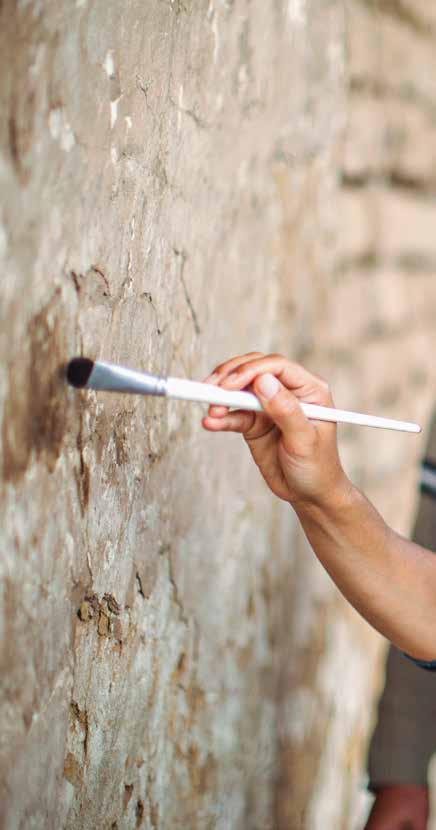
One trip is not enough to discover all the wonders of Peru. Natural destinations, archaeology, adventure, entertainment, delight and relaxation come together to create a unique journey where each traveller can plan a particular itinerary by choosing from different activities or just doing them all.
To help you plan your trip, here are some of the highlights of the country as well as magical places which are not to be missed. Enjoy them to the fullest!

Caballitos de totora (Totora reed boats). These vessels are handmade from totora reeds and were used by people belonging to the Moche and Chimu cultures for fishing. Currently, they are a work tool and a form of transportation for fishermen and vacationers who surf the waves at Huanchaco Beach (La Libertad), Pimentel Beach and Santa Rosa Beach (Lambayeque).
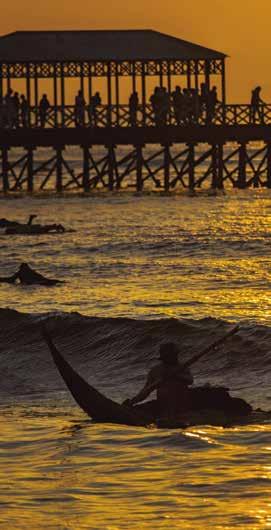
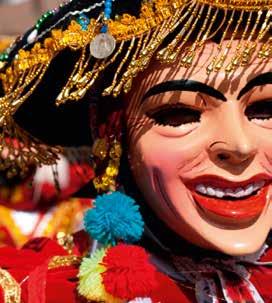
Traditional festivals are celebrated throughout Peru. During the festival of Virgen del Carmen (Virgin of Carmel) in Paucartambo (Cusco), the image of the virgin is taken out in a procession surrounded by dancers as well as magical and religious characters.
Resort of Huanchaco © Alex Bryce / PROMPERÚ Parade with dancers in Paucartambo © Walter HupiuMany of the festivals, rituals, and ways of life you can see today in Peru are much the same as they were during the pre-Columbian era. From the clothing to the popular art expressions, from belief systems to working and even cooking styles; Peru overflows with expressions that maintain the legacy of its millenary cultures.
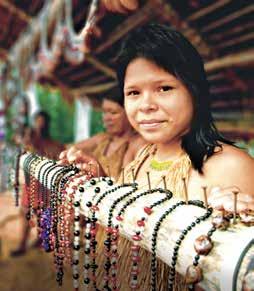
Indigenous Amazonian communities. In addition to being a refuge for biodiversity, the Peruvian rainforest is home to communities that have their own identity, language, and customs such as the Yagua community from Loreto.
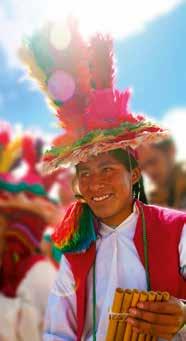
Rural community tourism. There are plenty of areas in Peru that have not yet been influenced by modernity and still keep their ancient traditions such as the island of Taquile in Lake Titicaca (Puno) which is home to a community of weavers.
Yagua artisan, Loreto © Christian Jara / PROMPERÚ Musicians in Taquile island, lake Titicaca © Janine Costa / PROMPERÚ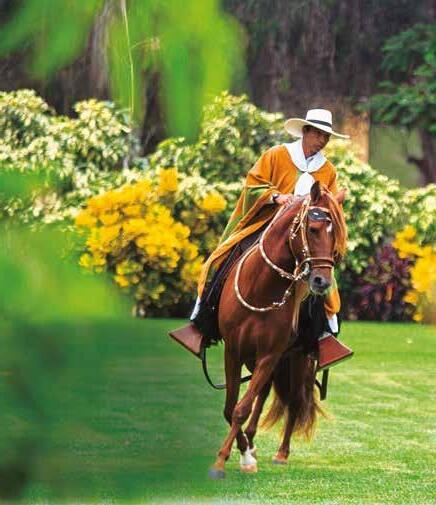
Watch the dance of the Peruvian paso horse on the outskirts of Lima at the haciendas and fields of the Lurin Valley.
This breed of unique characteristics stands out for its particular gait which looks more like a dance step than a horse trot.
In April, the best horse breeders display their specimens in the National Peruvian Paso Horse Contest at the Hacienda Mamacona. 5

Entertainment night and day. Besides bars, restaurants, and discotheques, there are plenty of cultural attractions in Lima such as theater plays, fashion shows, film festivals, art exhibits, concerts as well as photography, book, and food fairs, just to name a few. 6
Central restaurant © Ernesto Benavides / PROMPERÚ Mamacona Ranch © Daniel Silva / PROMPERÚThere is
Peru’s capital city is on the Pacific coast, where you can enjoy the richness of the sea all year long. It features modern restaurants, shopping malls, and entertainment venues; along with these locations there are Colonial neighborhoods and historical museums where you can discover the traditional side of the city, spending nights full of art, music, and fun in bohemian districts.
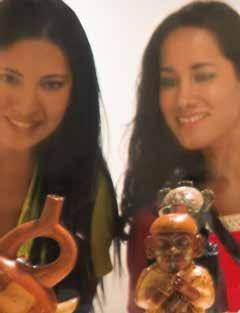
City of museums. Peru’s history is reflected in the diverse museums of the city through the extraordinary collections of gold and silver pieces, textiles, and ceramics from ancient Peru as well as artworks and handicrafts.
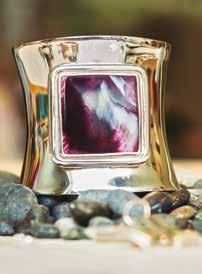
Shopping destination. In Lima, it is possible to find handicrafts and products from all over the country such as fine garments made of cotton, vicuña and alpaca fiber; gold and silver jewelry; embroidered cushions, retablos from Ayacucho, pottery from Chulucanas (Piura), blankets and carpets from Cusco, among others.
Chancay archaeological piece in Larco Herrera Museum © José Orihuela / PROMPERÚ Peruvian silver © Renzo Tasso / PROMPERÚ9
Rafting the Urubamba River, in Cusco. This river features short rapids of low technical difficulty as well as thundering rapids of greater difficulty and risk.
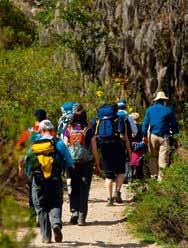
10
Inka Trail in Cusco.
It is such an experience to take some of the trails the Inkas marked in order to connect their empire, especially when the final destination is the impressive Inka city of Machupicchu.
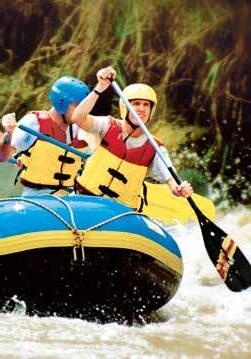

11
Surfing and other marine sports. Expert surfers can ride the longest left hand wave in the world (2 km / 1.2 mi) in Puerto Chicama (Trujillo - La Libertad).
Ocean lovers can engage in other sports such as fishing, jet skiing, windsurfing, and kite surfing among others.
12
Tambopata National Reserve in Madre de Dios.
It is such an adventure to access the reserve sailing down the river and then staying at one of the local lodges.

Peru displays impressive landscapes throughout its territory. The warm desert coast, the stunningly diverse highlands, and the lush rainforest are an invitation to extreme experiences.
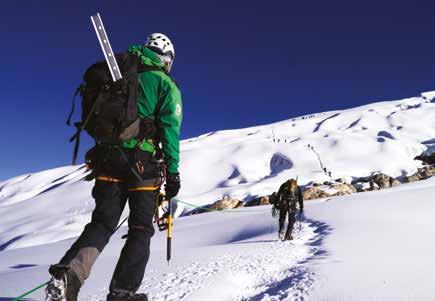
Mountain climbing in the Cordillera Blanca in Ancash. This stunning mountain range is home to the highest mountain in Peru: Mount Huascaran (6,768 m / 22,205 ft). The Huascaran National Park protects the region’s flora and fauna as well as the scenic beauty. The place is excellent for expeditions and trekking. 13

14
Paracas National Reserve, Ica. The ideal setting to practice a wide variety of sports. Start the day in the ocean, letting yourself be carried by the waves or the sea breeze. The perfect location for kitesurfing and paragliding, the reserve’s beaches are also ideal for surfing, diving, and other nautical activities.
Huascarán National Park © Julio Maguiña
Acllawasi
Pachacamac Archaeological Sanctuary in Lima. This oracle of God Pachacamac is 45 minutes south of Lima (31,5 km / 22 mi). This was once the main Inka worshiping center on the coast and features temples and pyramids from the Lima, Wari, and Ychsma cultures which preceded the Inkas.
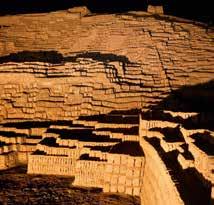
Huaca Pucllana and
Lima.
Both ceremonial centers belong to the Lima culture (200 - 650 A.D.) and are located at residential areas in the capital city.
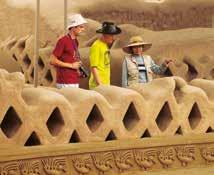
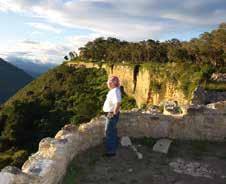
Monumental Archaeological Zone of Kuelap in Amazonas. It features 20-meter / 66-feet high walls which turn it into a monumental construction built around 700 years ago at 3,000 masl / 9,843 fasl by the Chachapoya.
Tombs, pyramids, and palaces in Lambayeque and La Libertad.
Chan Chan is the largest pre-Hispanic mud city and the former capital of the Chimu culture (900 - 1470 A.D.). This sacred site as well as other huacas and temples such as the archaeological complex El Brujo in Magdalena de Cao, are accessible from the city of Trujillo in La Libertad.
The Museum Royal Tombs of Sipan, located in Chiclayo (Lambayeque), displays the gold and silver belongings of a Moche dignitary (0 - 800 A.D.) found in a burial site; and in Batán Grande is the tomb of Señor de Sican (Lord of Sican) together with an impressive group of adobe pyramids from the Lambayeque culture (800-1300 A.D.). 17
Huaca Huallamarca inThere is
From the oldest civilization in the Americas to the largest and most powerful empire in South America, Peru is the caretaker of the architectural vestiges and artistic heritage of fascinating cultures. Having the chance to see them is an unforgettable experience.

Machupicchu, Cusco, and their surroundings. The Inka city of Machupicchu, which means “old mountain” in Quechua, is one of the New 7 Wonders of the Modern World. This millenary construction, located just over 110 km (68 mi) by train from the city of Cusco, mimics the shape of the mount it owes its name to and is next to Mount Waynapicchu which means “young mountain” in Quechua.
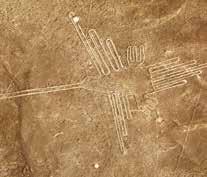
Nasca Lines and Geoglyphs in Ica. These mysterious lines furrowed by the Nascas are gigantic geometric, anthropomorphic, and zoomorphic shapes with lengths and depths of up to 275 m / 902 ft and 30 cm / 12 in respectively. The legacy of this culture is still maintained after nearly 1500 years.
Panoramic view of Machupicchu © Renzo Tasso / PROMPERÚ The Hummingbird of The Nasca Lines © Heinz Plenge / PROMPERÚColca Valley in Arequipa. This is an awesome spot for watching the majestic condor soar among mountains, which are up to 5,000 m / 16,400 ft high, and the sheer cliffs of the Colca Canyon, one of the world’s deepest at 4,160 m / 13,648 ft.
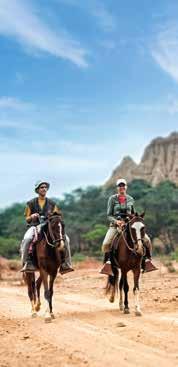
The Bosque de Pomac Historic Sanctuary and the Chaparrí Private Conservation Area in Lambayeque. The first is a fertile ecosystem that shelters mammalian species such as wildcats and a variety of birds such as the Peruvian plantcutter, the burrowing owl and the lineated woodpecker. The second one is located in the dry forests of Lambayeque featuring a great variety of wild life species such as the spectacled bear and the white-winged guan.
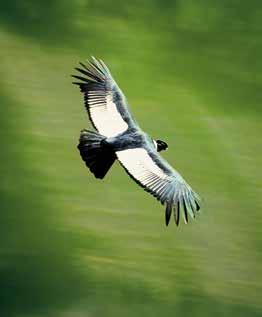
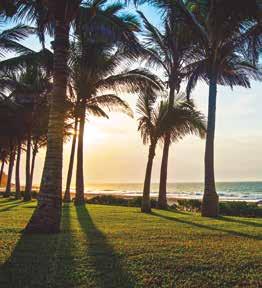
Northern beaches in Tumbes and Piura. It is summer all year long on Peru’s northern coastline where you can always enjoy the beaches, the good hotel infrastructure, and its famous cuisine. Furthermore, it is a perfect place for watching humpback whales as they migrate to Antarctica from July to October.
Las Pocitas Beach, Piura © Marcela Delgado / PROMPERÚ Andean condor © Heinz Plenge / PROMPERÚ Historic Sanctuary of the Pómac Forest © Mylene d’Auriol / PROMPERÚCome to see why Peru is one of the 10 megadiverse countries in the world. Get amazed by its 84 life zones, 28 types of climate, incomparable landscapes and locations which are home to a unique variety of fish, butterflies, birds, and orchid species. Come and enjoy Peru!

Manu National Park and Tambopata National Reserve in Madre de Dios. These are two of the most important protected natural areas in the country where an enormous variety of birds, mammals, fish, insects, reptiles and plant species thrive, many of them endemic.
Emperor Tamarin monkey
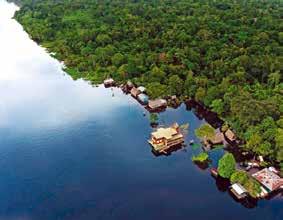
Amazon River © Delfin Amazon Cruises
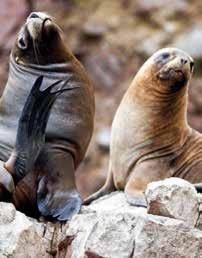
The Amazon River and Pacaya-Samiria National Reserve in Loreto. It is possible to start your trip in Iquitos, sailing down the Amazon River, which originates in Peru, towards the national reserve, an area featuring a tropical rainforest home to a rich flora and fauna which includes pink dolphins that are found only in these waters.
Paracas National Reserve and the Ica Desert in Ica. The reserve and the neighboring Ballestas Islands are home to sea lions, Humboldt penguins, dolphins, flamingos, and other birds. Farther south, you enter into a desert of amazing sand dunes and the Huacachina Oasis.
Natural energy. There are destinations where you can still unplug from the world; places as amazing as they are legendary which fill us with energy and delight.
Drinking a glass of champagne in a Bedouin tent in the midst of the Ica desert or enjoying a sunny afternoon in a private country house with access to a spa and thermal waters in a valley in Arequipa are just some of the experiences you can enjoy.
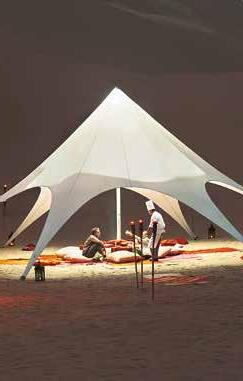
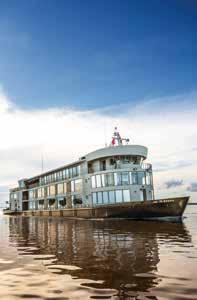
Luxury Amazon cruises. This is a unique opportunity to visit native communities and see exotic Amazonian flora and fauna, all in the comfort of a five-star trip with specialized guides and gourmet food.

Lima and the art of good eating. Peru’s capital is also the culinary capital of the Americas. Lima has turned into a true caldron of flavors due to the variety and wealth of ingredients from the coast, highlands, and rainforest; the blending of ancient and modern cooking techniques; and the fusion of influences from different cultures like the Chinese, the Japanese, the Afro-Peruvian, and the European one resulting in a culinary melting pot that is now an important part of the Peruvian identity. The “trio de cebiches”, a fish and seafood based dish, is just one of the great delicacies offered in Lima.
Bedouin tent in the Paracas desert © Janine Costa / PROMPERÚ Cebiches © Yayo López / PROMPERÚ Amazon River © Delfin Amazon CruisesIn Peru it is possible to enjoy everything to the maximum. There are activities set apart for those who want to experience the luxury of visiting some of the most sublime locations on the coast, highlands, and rainforest, coupled with personalized service.

Boutique hotel.
A top flight stay in Colonial houses, ancient monasteries, or designer hotels with the possibility of delighting yourself in gourmet dinners and 100% personalized service.
Hotel boutique in Trujillo © Alex Bryce / PROMPERÚTravelers will only be granted entry to Peru if they present to the immigration official with a passport valid for at least six months.
Citizens of Bolivia, Brazil, Colombia, Chile, Ecuador, Argentina, Paraguay, and Uruguay can enter with their national identification document. Venezuelan citizens must have a passport and visa to enter Peru.
For longer stays, including stays for other purposes (residency, study, work, etc.), it is necessary to apply at the Peruvian Consulate in your home country prior to your trip.
The list of import duty-exempt goods at the following web page: www.sunat.gob.pe/orientacionaduanera/viajeros/index.html
International flights arrive at Jorge Chávez Airport where domestic flight connections are available to visit the main touristic destinations in Peru.
Options include one to five star hotels, boutique hotels, hostels, and lodges.
In order to avoid altitude sickness when travelling to the Andes, it is recommended to rest the first day of arrival, have light meals, drink a lot of water, and have lemon candies handy.
Before travelling to the rainforest, make sure to carry insect repellent to protect yourself from mosquito bites and have a yellow fever vaccination ten days prior to the trip.
To prevent gastrointestinal infections, it is recommended to avoid eating uncooked and street food, and to only drink bottled or boiled water.
In case of having a heart condition, please ask your physician before travelling to destinations at high altitude.
The sol (S/) is the official currency of Peru. US dollar ($) is accepted at some local businesses, restaurants, and service stations.
Transactions are accounted at the current exchange rate.
You may exchange euros, dollars and other foreign currencies at authorized exchange houses. It is not recommended to exchange money with street money changers.
The main cities in the country have ATMs. Among the most accepted credit cards are American Express, Visa, Diners, and Mastercard. Traveller´s check
Not all commercial establishments accept traveller's check. Check with vendor befores buying or ordering.
With the exception of some cities in the Amazon, it is possible to travel to different local destinations by bus. Fares vary by level of comfort.
Several taxi companies offer their services around the clock, from and to the airport or to other destinations. Cash payment only.
The main car rental companies in the world have offices in our country. All-terrain (4x4) vehicles are the ones most in demand when visiting regions of rugged terrain. To drive in Peru you must have the following:
• Current national driver’s license (issued in the country of origin)
• Copy of your passport
• SOAT insurance
• Proof of technical inspection
• Vehicle registration
• Rental contract (for rented vehicles)
• Current international driver’s license valid for 1 year.
Peruvian cuisine is famous for its variety and excellence. Some dishes can be spicy or highly seasoned and each region has its own culinary style.
Safety precautions to be taken when visiting Peru are the same as in any other tourist destination, such as not leaving your personal belongings unattended in public areas and avoiding deserted areas at night.
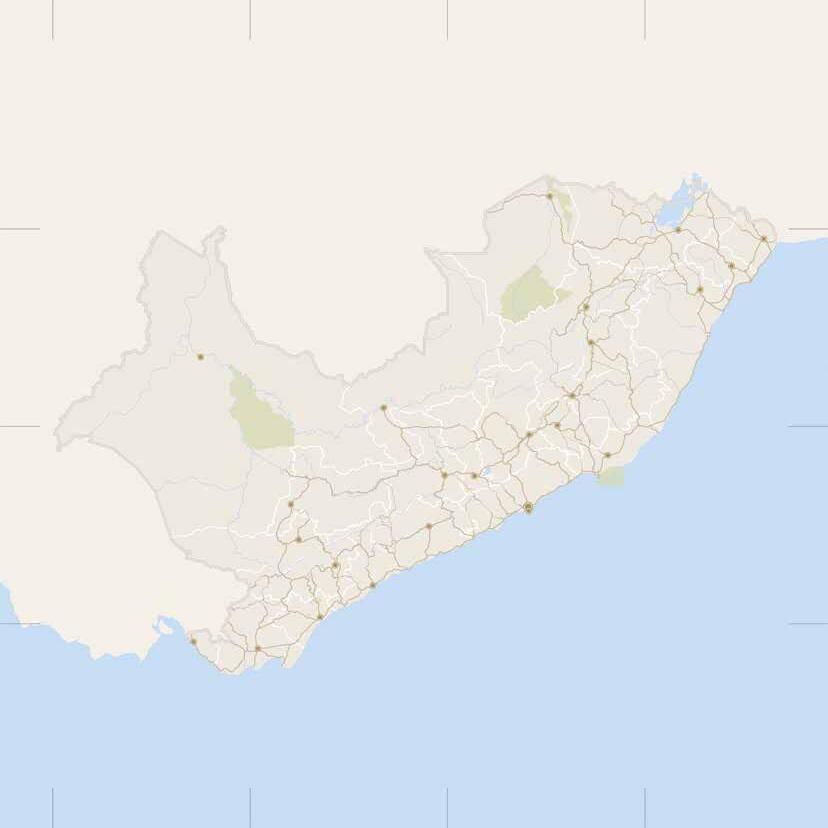
Northern Beaches
Bayóvar Paita
Pómac Forest and Chaparrí
Huanchaco
Chiclayo Trujillo

The given borders do not prejudge the international borders.
Aprobado por R.D. N° 0134
del 20 de abril de 2015
www.peru.travel
Una publicación de la Comisión de Promoción del Perú para la Exportación y el Turismo - PROMPERÚ.
Calle Uno Oeste n.° 50, piso 14, urb. Córpac, San Isidro, Lima-Perú Teléfono: (51-1) 616-7300
www.promperu.gob.pe
© PROMPERÚ. Todos los derechos reservados. Distribución gratuita. Prohibida su venta.
HECHO EL DEPÓSITO LEGAL EN LA BIBLIOTECA NACIONAL DEL PERÚ n.° 2019-18315
Imprenta: Lance Gráfico S.A.C. (Calle Mama Ocllo 1923) Lima, diciembre de 2019
Idioma: Inglés